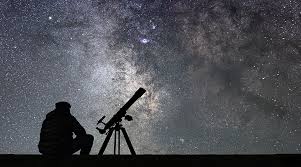TELESC OPE
OPE
If life is like a box of chocolates (Forest Gump), then faith is like a telescope.
We have a choice in faith — the choice of which end of the telescope to look through.
Looking through the eye-piece helps us to see things far away with more depth. Looking through the opposite end does the opposite — things that are near appear small and distant, even distorted.
Let’s leave the analogy for a moment and jump to a parallel thought. There are three primary truths about faith: 1. God is. 2. God is love. 3. We understand neither God nor love.
Using the telescope as it is meant to be used helps us maintain perspective on these truths. Our field of vision is expanded. We see the vastness before us with a little better perspective. It doesn’t explain anything. Our questions are not answered; our questions are put into perspective when we see the wondrous beauty and complexity of God’s creation. It helps turn our gaze outward from our limited selves to our unlimited Creator.
Looking through the wrong end leads to a loss of perspective. Our field of vision is limited and the edges of our view are distorted. Near things seem far away and the world becomes small and confined.
We confine ourselves. We focus on the minutia of what’s before us rather than the wonder that is beyond us. The distorted view brings us no wonder, no marvel, no amazement of the delicate beauty of Creation. The elegant complexity of everything evades us — contradictory terms, but true. Science continues to unravel the intricate complexity of life, yet faith also sees the elegant simplicity in the love that holds it all together (Col 1:17, “…and in Him (Jesus) all things hold together”). The distorted view leaves us only our little bit of immediacy to work with. We lose sight of the three truths — perhaps not completely, but our focus and attention is diverted. We too easily drift back to our microcosm of smallness and pettiness, focused on the wrong things in the wrong way.
Faith, like a telescope, should bring the distant forward, not push what’s before us further away.
God intends to draw us into the wonder of God’s love — not for us to understand it, define it, and control it, but that we would experience it, accept it, marvel at its limitlessness. Ultimately if we do not allow it to draw us out of ourselves into something greater, into what we are created for, we condemn ourselves to the smallness of our aloneness. We capitulate to the dismal resignation that this existence of ours is all that there is.
Faith’s first response is to marvel at what we discover. It encourages us to continue to look beyond ourselves, to see more and see further. It leads us to acknowledge those eternal truths. 1. God is — self-evident as it is to the eyes of faith, it is not within the field of vision otherwise. It is said that for those who believe, no proof is necessary; for those who refuse to believe, no proof is possible. 2. God must be love — Faith’s eyes not only see it, they feel it, and ask, what else could or would create such beautiful diversity. 3. We understand neither God nor love, and faith’s eyes cannot resist being drawn to it. Yet the distorted view cannot see it and insists on defining the undefinable. When it fails, it denies it.
Our first look is with an eye to analyze and know, and we do this through detachment and objectivity. Depth, beauty and wonder are only seen through the second gaze of love (Rohr, Fr. Richard, The Divine Dance, p.51).
If we do not allow ourselves the second gaze that draws us in, to know that we are not only part of what we see, but also know that this is who we are, we remain standing at the train station called Analysis, watching the train named Beauty and Love pass by on its journey of faith.
John of the Cross said, “God refuses to be known but can only be loved”.
God can never be an intellectual knowledge. The way we know God is through a knowledge of participation, because love does not bear analysis.
Love can only be lived. God can only be experienced.
